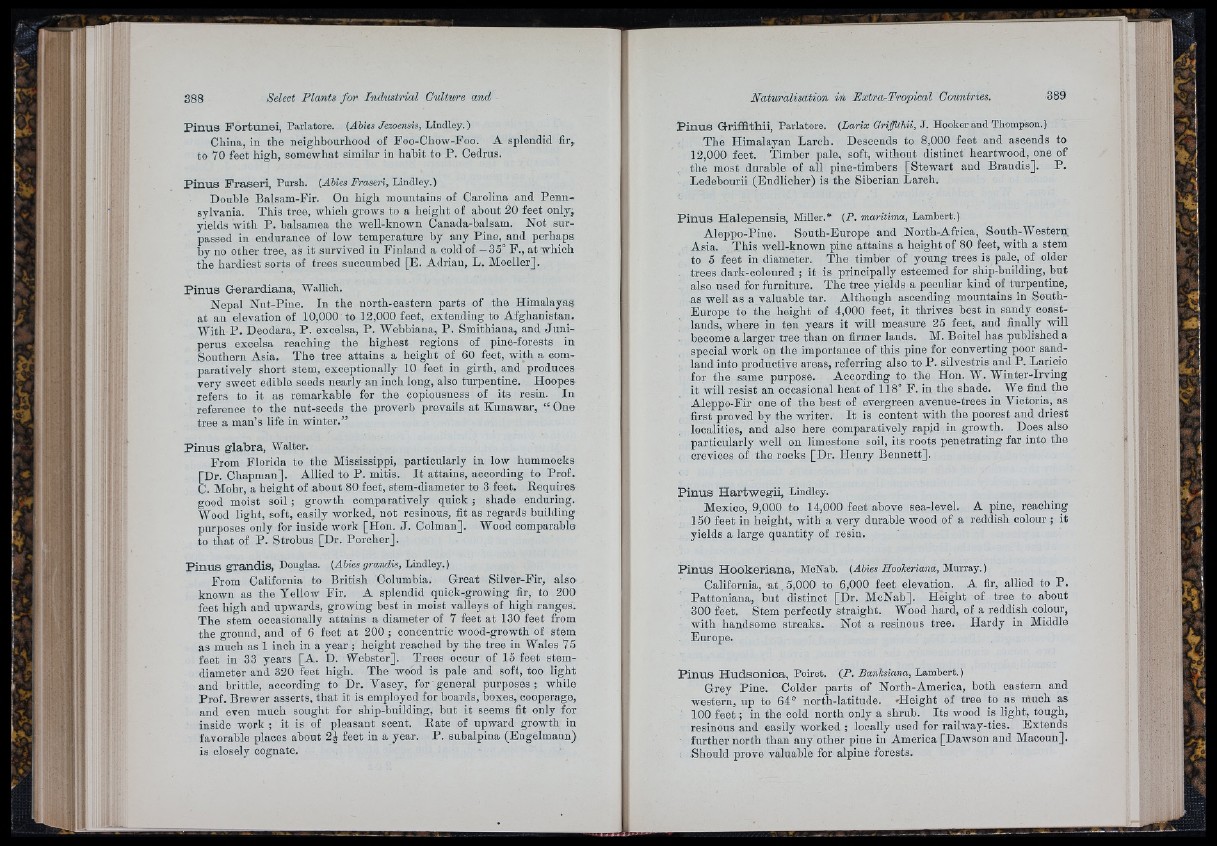
P in u s F o r tu n e i, Parlatore. (Ahies Jewensis, lin d le y .)
Cliina, in the neighbourhood of Foo-Chow-Foo. A splendid fir,,
to 70 feet high, somewhat similar in habit to P . Cedrus.
P in u s F ra s e ri, Pursh. (Ahies Fraseri, Lindley.)
Double Balsam-Fir. Ou high mountains of Carolina and Pen n sylvania.
This tree, which grows to a height of about 20 feet only,
yields with P. balsamea the well-known Canada-balsam. Not surpassed
in endurance of low temperature by any Pine, and perhaps
by no other tree, as it survived in Finland a cold of —35° F., at which
the hardiest sorts of trees succumbed [E. Adrian, L. Moeller].
P in u s G e ra rd ia n a , Wallich.
Nepal Nut-Pine. In th e north-eastern parts of the Himalayas
at an elevation of 10,000 to 12,000 feet, extending to Afghanistan.
With P . Deodara, P . excelsa, P. Webbiana, P . Smithiana, and Ju n iperus
excelsa reaching the highest regions of pine-forests in
Soutliern Asia. The tree attains a height of 60 feet, with a comparatively
short stem, exceptionally 10 feet in girth, and produces
very sweet edible seeds nearly an inch long, also turpentine. Hoopes
refers to it as remarkable for the copiousness of its resin. In
reference to the nut-seeds the proverb prevails a t Kunawar, “ One
tree a man’s life in winter.”
P in u s g-labra, Walter.
From Florida to the Mississippi, particularly in low hummocks
[Dr. Chapman]. Allied to P. mitis. I t attains, according to Prof.
C. Mohr, a height of about 80 feet, stem-diameter to 3 feet. Eequires
good moist soil ; growth comparatively quick ; shade enduring.
Wood light, soft, easily worked, not resinous, fit as regards building
purposes only for inside work [Hon. J . Colman]. Wood comparable
to th a t of P . Strobus [Dr. Porcher].
P in u s g ra n d is , Douglas. (Ahies grandis, Lindley.)
From California to British Columbia. Great Silver-Fir, also
known as the Yellow Fir. A splendid quick-growing fir, to 200
feet high and upwards, growing best in moist valleys of high ranges.
The stem occasionally attains a diameter of 7 feet a t 130 feet from
the ground, and of 6 feet at 200 ; concentric wood-growth of stem
as much as 1 inch in a year ; height reached by the tree in Wales 75
feet in 33 years [A . D. Webster]. Trees occur of 16 feet stem-
diameter and 320 feet high. The wood is pale and soft, too light
and brittle, according to Dr. Vasey, for general purposes; while
Prof. Brewer asserts, that it is employed for boards, boxes, cooperage,
and even much sought for ship-building, but it seems fit only for
inside work ; it is of pleasant scent. Rate of upward growth in
favorable places about 2 | feet in a year. P . subalpina (Engelmann)
is closely cognate.
P in u s Grifflthii, Parlatore. (Larix Oriffithii, J. Hooker and Thompson.)
The Himalayan Larch. Descends to 8,000 feet and ascends to
12,000 feet. Timber pale, soft, without distinct heartwood, one of
the most durable of all pine-timbers [Stewart and Brandis]. P.
Ledebourii (Endlicher) is the Siberian Larch.
P in u s H a le p e n s is , Miller.* (P. maritima, Lambert.)
Aleppo-Pine. South-Europe and North-Africa, South-Western;
Asia. This well-known pine attains a height of 80 feet, with a stem
to 5 feet in diameter. The timber of young trees is pale, of older
trees dark-coloured ; it is principally esteemed for ship-building, but
also used for furniture. The tree yields a peculiar kind of turpentine,
as well as a valuable tar. Although ascending mountains in South-
Europe to the height of 4,000 feet, it thrives best in sandy coast-
lands, where in ten years it will measure 25 feet, and finally will
become a larger tree than on firmer lands. M. Boitel has published a
special work on the importance of this pine for converting poor sand-
land into productive areas, referring also to P. silvestris and P. Larieio
for the same purpose. According to the Hon. W. Winter-Irving
it will resist an occasional heat of 118° F. in the shade. We find the
Aleppo-Fir one of the best of evergreen avenue-trees in Victoria, as
first proved by the writer. I t is content with the poorest and driest
localities, and also here comparatively rapid in growth. Does also
particularly well on limestone soil, its roots penetrating far into the
crevices of the rocks [D r. Henry Bennett].
P in u s H a rtw e g ii, Lindley.
Mexico, 9,000 to 14,000 feet above sea-level. A pine, reaching
160 feet in height, with a very durable wood of a reddish colour ; it
yields a large quantity of resin.
P in u s H o o k e ria n a , MoNab. (Abies Hookeriana, htwcvay.)
California, a t , 5,000 to 6,000 feet elevation, A fir, allied to P .
Pattoniana, but distinct [Dr. McNab]. Height of tree to about
300 feet. Stem perfectly straight. Wood hard, of a reddish colour,
with handsome streaks. Not a resinous tree. Hardy in Middle
Europe.
P in u s H u d so n ic a , Poiret. (P. Banksiana, Lambert.)
Grey Pine. Colder parts of North-America, both eastern and
western, up to 64° north-latitude. »Height of tree to as much as
100 feet ; in the cold north only a shrub. Its wood is light, tough,
resinous and easily worked ; locally used for railway-ties. Extends
further north than any other pine in America [Dawson and Macoun].
Should prove valuable for alpine forests.
■ iJ
.. i.r
ri